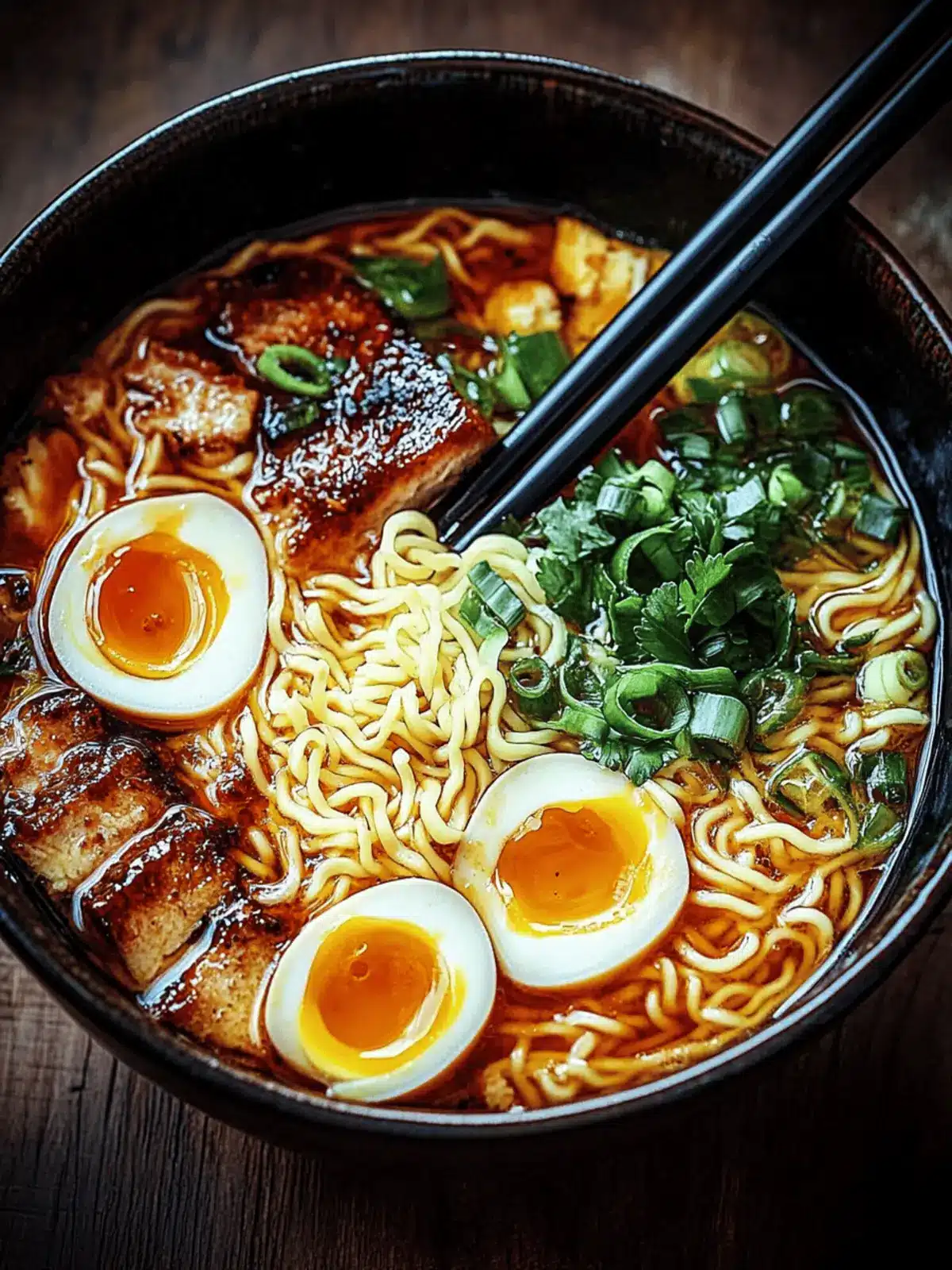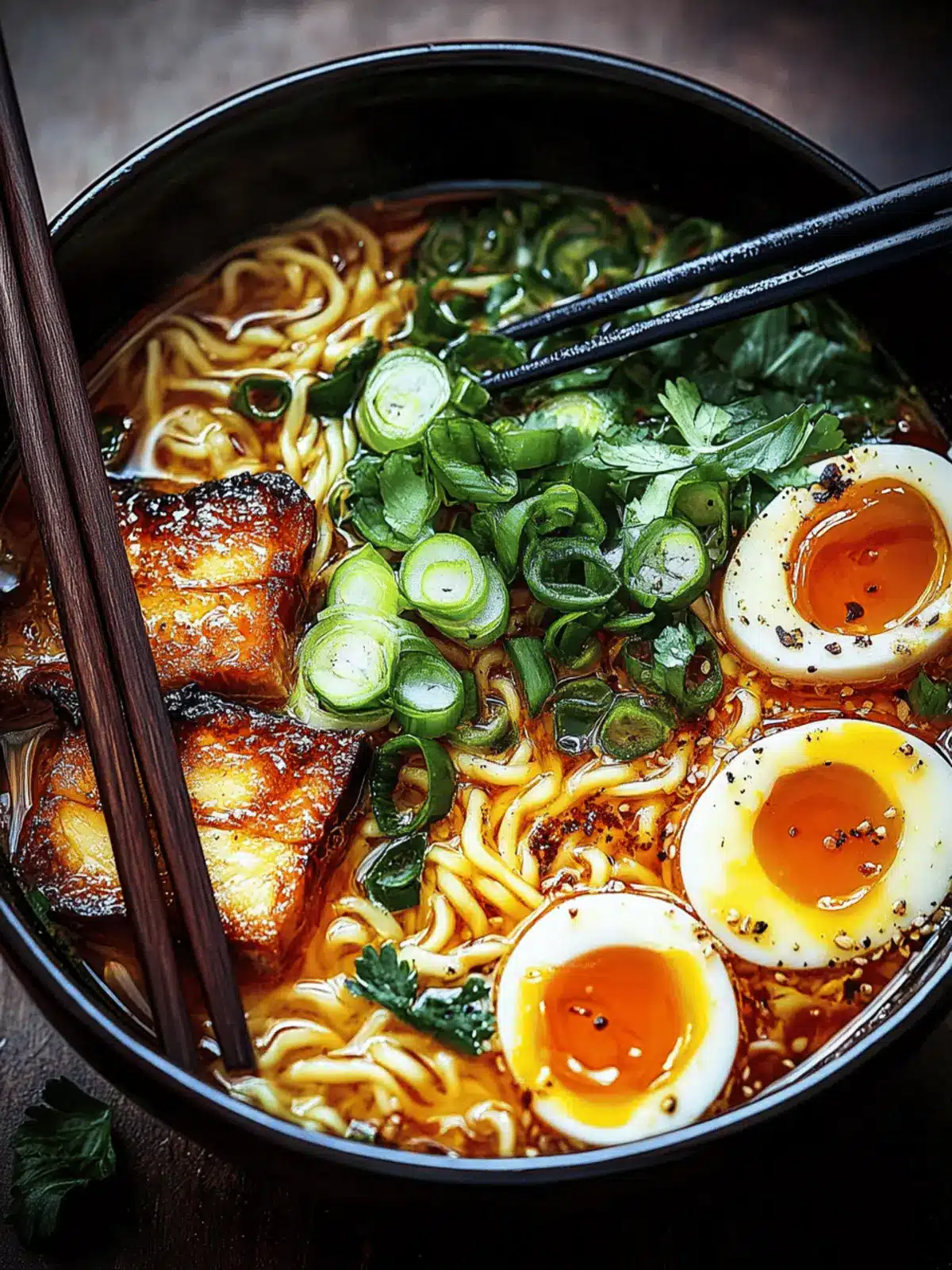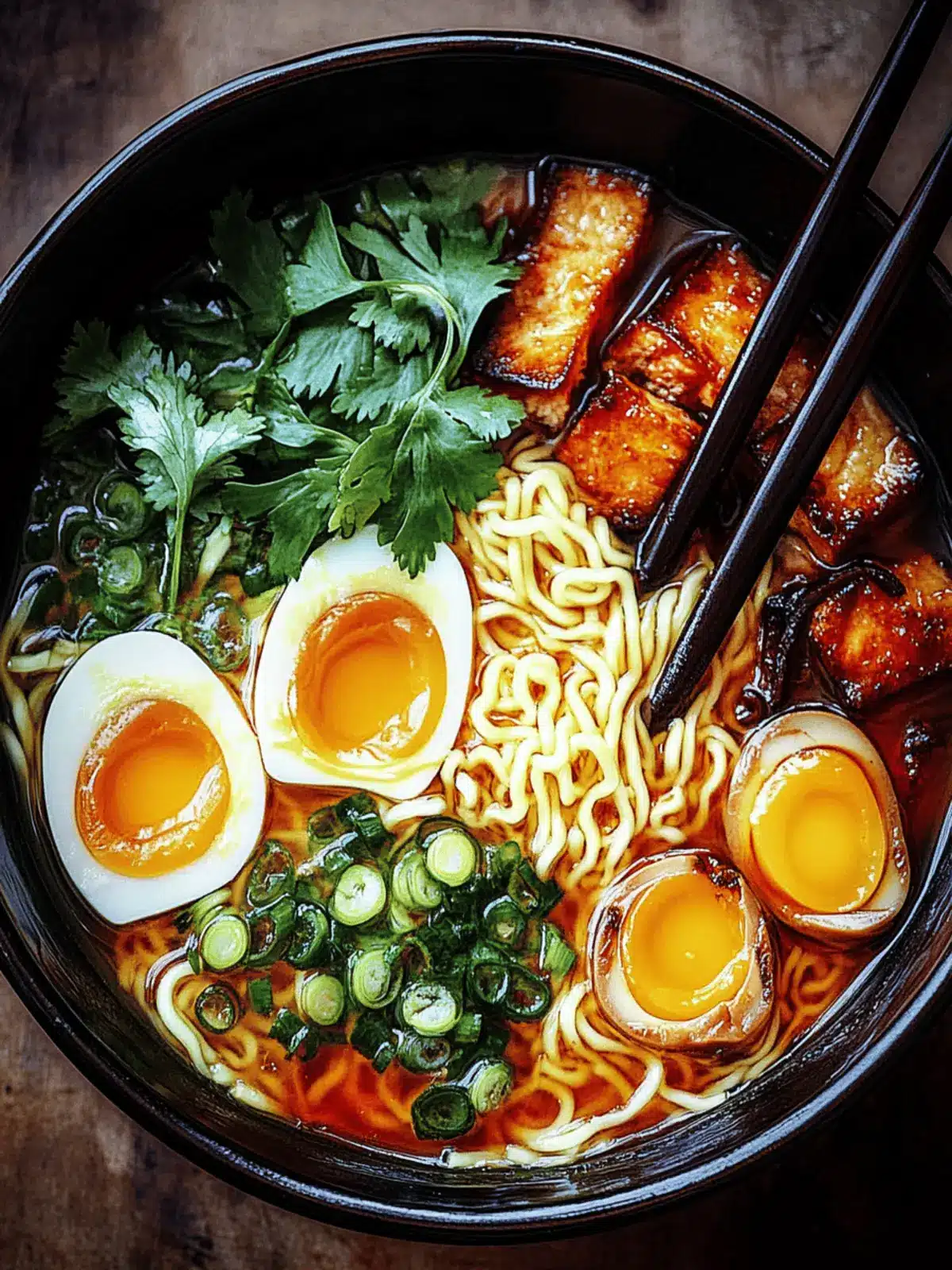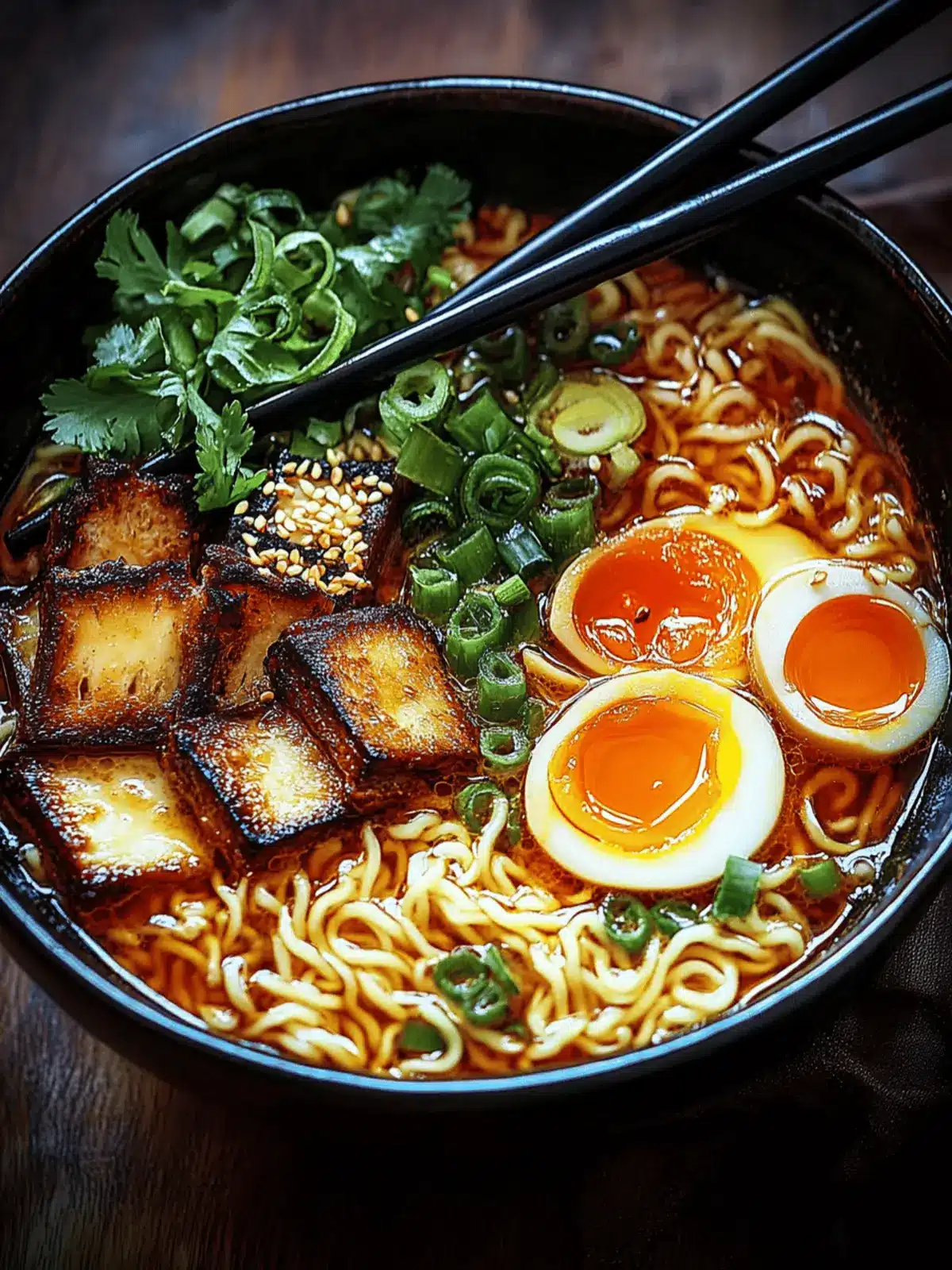There’s something special about the comforting allure of a steaming bowl of ramen noodle soup, an embrace that warms from the inside out. Picture this: after a long day, I find solace in the inviting aroma of garlic and fresh ginger mingling together as they gently sauté in my kitchen. In just under 30 minutes, I can craft a flavorful masterpiece that not only satisfies my cravings but also invites creativity through customizable toppings. Whether it’s crisp bok choy, vibrant carrots, or a dash of chili oil for a kick, this dish is as flexible as it is delicious. Perfect for cozy nights in with loved ones or impressing dinner guests, you’ll discover that mastering the art of ramen noodle bowls is not just a recipe; it’s a delicious journey waiting to unfold in your kitchen. Join me and experience the joy of this heartwarming classic!
Why are Ramen Noodle Bowls so irresistible?
Delicious, flavor-packed experience: Each bowl is a hearty blend of rich broth and springy noodles, creating a symphony of taste that warms your soul. Quick and easy: Ready in just 30 minutes, it’s the perfect midweek meal for busy nights. Customizable toppings: From soft-boiled eggs to vibrant veggies, you can personalize each bowl to fit your cravings. Vegetarian-friendly option: Easily switch to vegetable broth and plant-based toppings for a hearty meatless meal. Get ready to master this comforting classic that is sure to impress family and friends!
Ramen Noodle Bowls Ingredients
• Discover the essentials for Ramen Noodle Bowls that delight!
-
For the Broth
-
Chicken or Vegetable Broth – The base flavor of the soup; choose vegetable broth for a vegetarian-friendly version.
-
Soy Sauce (2 tablespoons) – Adds umami and saltiness to enhance the broth’s richness; opt for low-sodium if preferred.
-
Miso Paste (1 tablespoon) – Deepens the flavor profile and enhances umami; white miso offers a milder taste.
-
For the Noodles and Vegetables
-
Fresh Ramen Noodles (14 oz) – The main component providing delightful texture; soba or udon can be good substitutes.
-
Bok Choy (1 cup, chopped) – Adds greens and texture; spinach or other leafy greens work as great alternatives.
-
Carrot (julienned) – Contributes sweetness and crunch; bell peppers can be used for extra color and flavor.
-
Aromatics and Seasonings
-
Garlic (2 cloves, minced) – Infuses the dish with aromatic depth; adjust or omit for a milder taste.
-
Ginger (1 inch, grated) – Provides warmth and spice; using fresh ginger ensures the best flavor.
-
Green Onions (2, sliced) – Bring freshness and a delightful crunch; chives are a mild substitution.
-
Optional Protein and Toppings
-
Soft-Boiled Eggs (2, optional) – Add rich protein for a finishing touch; omit for vegan options, or swap with tofu.
-
Chili Oil (optional) – For a spicy kick, adjust to your heat preference for added zest.
-
Sesame Oil – For drizzling, enhances nuttiness; this is also optional.
-
Seaweed Sheets (optional) – Garnishes with extra flavor; skip for a lighter dish.
How to Make Ramen Noodle Bowls
-
Prepare the Pot: Start by filling a large pot with water and place it over medium heat. Allow the water to warm gradually while you prepare your toppings and ingredients.
-
Gather Toppings: While waiting for the water to heat, gather your toppings such as chopped bok choy, sliced carrots, and green onions. Make sure everything is prepped and within reach for easy assembly later.
-
Sauté Aromatics: In a separate pan, drizzle a bit of oil and sauté minced garlic and grated ginger over low heat. Stir until everything is golden and fragrant, about 2-3 minutes.
-
Simmer the Broth: Pour in your chicken or vegetable broth to the pan with the sautéed aromatics. Bring it to a gentle simmer, letting the flavors meld together for about 5-10 minutes.
-
Cook the Noodles: While the broth simmers, drop your ramen noodles into a separate pot of boiling water. Cook them for 3-4 minutes, stirring occasionally to prevent sticking, until they’re springy but tender.
-
Combine and Serve: Once the noodles are cooked, drain them and divide into serving bowls. Ladle the rich broth over the top, then artfully arrange your toppings like bok choy, carrots, and soft-boiled eggs for an appealing presentation.
-
Finish with Drizzles: If desired, add a few drops of sesame oil and chili oil over each bowl for an extra layer of flavor.
Optional: Garnish with a sprinkle of sliced green onions for added freshness.
Exact quantities are listed in the recipe card below.
How to Store and Freeze Ramen Noodle Bowls
-
Fridge: Store leftovers in an airtight container for up to 2 days. Keep the broth and noodles separate to prevent sogginess and maintain texture.
-
Freezer: For longer storage, freeze the broth in ice cube trays and the toppings separately for up to 3 months. Cook noodles fresh each time for best results.
-
Reheating: When ready to enjoy, reheat the broth in a pot over medium heat until hot. Quickly cook fresh ramen noodles in boiling water, and then assemble your bowl with heated broth and desired toppings.
What to Serve with Ramen Noodle Soup?
Imagine the comforting aroma of a steaming bowl of nourishing broth threading through your kitchen, inviting warmth and happiness.
- Crispy Spring Rolls: These golden bites offer a delightful crunch that contrasts beautifully with the slurpy noodles, creating a well-rounded meal.
- Edamame Beans: Lightly salted and simply prepared, their firm texture and subtle flavor make an elegant side that complements the soup’s richness.
- Pickled Vegetables: A tangy assortment of pickled radishes or cucumbers can cleanse the palate, providing a refreshing balance to the savory elements of your ramen.
- Miso Glazed Eggplant: This dish brings a savory-sweet element to the table, perfectly enhancing the umami flavors of your ramen with its tender texture.
- Gyoza (Dumplings): These stuffed delights add a hearty and satisfying touch, perfect for pairing with the lightness of the noodle soup. The flavors meld beautifully, amplifying the overall dining experience!
- Chili Oil Topping: For an extra kick, a small dish of homemade chili oil allows guests to customize their spice level, adding a personal touch to each bowl.
- Green Tea: A warm cup of green tea can beautifully cleanse the palate while enhancing the overall flavor experience of the meal.
- Matcha Cheesecake: For dessert, consider a light and creamy matcha cheesecake; it ties in the Japanese theme and offers a sweet ending without being overly heavy.
- Fresh Citrus Salad: A vibrant salad of orange and grapefruit slices brightens up your meal, providing a refreshing contrast to the savory soup.
Expert Tips for Ramen Noodle Bowls
- Avoid Cloudy Broth: Keep a low simmer on your broth to ensure clarity and richness; too high of heat can result in bitterness.
- Perfect Noodle Texture: Cook ramen noodles separately and avoid overcooking; they should remain springy and not clump together when served.
- Gradual Seasoning: Adjust soy sauce and miso paste incrementally for depth; starting with less prevents overpowering flavors.
- Customizable Cooking Time: Depending on desired toppings, adjust cooking times slightly without compromising the overall harmony of the Ramen Noodle Bowls.
- Fresh Ingredients Matter: Use the freshest aromatics and toppings available for the best and most vibrant flavor in your dish.
Ramen Noodle Bowls Variations & Substitutions
Feel free to explore exciting twists and swaps to make these ramen noodle bowls your own!
- Dairy-Free: Omit any dairy toppings like soft-boiled eggs for a vegan-friendly bowl. Consider marinated tofu to add richness instead.
- Spicy Boost: Add a few slices of jalapeños or a spoonful of gochujang for a spicy kick that will awaken your taste buds.
- Texture Twist: Swap fresh ramen for crunchy rice noodles or spiralized zucchini for a gluten-free option. This creates a refreshing texture that brightens your dish.
- Protein Power: Incorporate shredded rotisserie chicken or grilled shrimp to boost protein content. This makes your bowl heartier while adding exciting flavor.
- Veggie Frenzy: Experiment with seasonal vegetables like snap peas or asparagus instead of bok choy. Each vegetable brings a different freshness, keeping your bowl vibrant.
- Umami Upgrade: Stir in a tablespoon of peanut butter or tahini for a nutty flavor infusion. This adds creaminess that perfectly complements the broth’s richness.
- Flavorful Broth: Use homemade bone broth for an even richer flavor. Simmering the broth longer yields deeper umami notes that enhance every bite.
- Herbaceous Finish: Garnish with fresh cilantro or basil to brighten your ramen noodle bowls beautifully. Herbs add a lovely aromatic touch that rounds out the flavors perfectly.
Make Ahead Options
These Ramen Noodle Bowls are a fantastic option for meal prep, saving you time during your busy weeknights! You can prepare the broth (without the noodles) and refrigerate it for up to 3 days for optimal flavor retention. Simply sauté the garlic and ginger, add your broth and seasonings, and allow it to cool before storing in an airtight container. For freshness, chop your vegetables like bok choy and carrots a day ahead, and keep them in the fridge. When it’s time to serve, heat the broth gently while cooking the noodles fresh in boiling water for 3-4 minutes. This way, you ensure that your ramen remains just as delicious and comforting!
Ramen Noodle Bowls Recipe FAQs
What type of broth should I use for Ramen Noodle Bowls?
Absolutely! You can use either chicken broth for a hearty flavor or vegetable broth for a vegetarian-friendly option. If you’re catering to specific dietary preferences, vegetable broth serves as a fantastic base that does not sacrifice taste.
How should I store leftover Ramen Noodle Bowls?
Great question! Store your leftovers in an airtight container in the fridge for up to 2 days. To maintain the quality, keep the broth separate from the noodles and toppings until you’re ready to enjoy them again, as this prevents the noodles from becoming soggy.
Can I freeze Ramen Noodle Bowls?
Of course! You can freeze the broth in ice cube trays for easy portioning and store any chopped vegetables or proteins separately in freezer bags for up to 3 months. When you’re ready to enjoy your ramen, simply heat the broth on the stovetop and cook fresh noodles to keep them perfectly springy.
What should I do if my broth is cloudy?
Very good point! To avoid cloudy broth, make sure to simmer it gently rather than boiling vigorously. This helps prevent impurities from being released into the broth, keeping it clear and flavorful. If you’re making a larger batch, skim any foam that rises to the top while it cooks.
Are there any dietary considerations for Ramen Noodle Bowls?
Yes, definitely! If cooking for someone with allergies, always check your soy sauce and miso paste for gluten or other allergens. For pet considerations, avoid sharing any ingredients like garlic and onions, as those can be harmful to pets. Always tailor the toppings to suit dietary needs, considering vegan substitutes like tofu or extra veggies for protein.

Delicious Ramen Noodle Bowls Ready in 30 Minutes or Less
Ingredients
Equipment
Method
- Prepare the Pot: Start by filling a large pot with water and place it over medium heat.
- Gather Toppings: While waiting for the water to heat, gather your toppings such as chopped bok choy, sliced carrots, and green onions.
- Sauté Aromatics: In a separate pan, drizzle a bit of oil and sauté minced garlic and grated ginger over low heat for about 2-3 minutes.
- Simmer the Broth: Pour in your chicken or vegetable broth to the pan with the sautéed aromatics and bring it to a gentle simmer for about 5-10 minutes.
- Cook the Noodles: While the broth simmers, drop your ramen noodles into a separate pot of boiling water and cook for 3-4 minutes.
- Combine and Serve: Once the noodles are cooked, drain them and divide into serving bowls. Ladle the broth over top, then arrange your toppings.
- Finish with Drizzles: If desired, add sesame oil and chili oil over each bowl for extra flavor.








